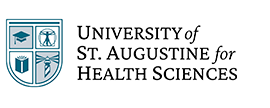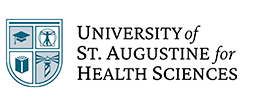USAHS is eligible for most VA education benefits:
- Chapter 30 – Montgomery GI Bill® (Active Duty)
- Chapter 31 – Vocational Rehabilitation Benefits
- Chapter 33 – Post-9/11 GI Bill® and Yellow Ribbon
- Chapter 35 – Survivors and Dependents Assistance
- Chapter 1606 – Reserve GI Bill®
Submit your Certificate of Eligibility to [email protected].
For questions about Veteran’s Education Benefits eligibility, call the VA at 888-GIBill1 (888-442-4551), Monday through Friday, 7 a.m. to 6 p.m. CT.
St. Augustine, FL, Campus – The entry-level Doctor of Physical Therapy, Doctor of Occupational Therapy, and Master of Occupational Therapy degree programs are approved by the Florida Department of Veteran Affairs for training of veterans and other eligible persons. Questions regarding benefits, enrollment certification, etc., should be directed to the certifying officer in the Financial Aid Office on the St. Augustine, Florida, campus.
San Marcos, CA, Campus – The entry-level Doctor of Physical Therapy, Doctor of Occupational Therapy, and Master of Occupational Therapy degree programs are approved by the California State Approving Agency for Veterans Education. Questions regarding benefits, enrollment certification, etc., should be directed to the certifying officer in the Financial Aid Office on the San Marcos, California, campus.
Austin, TX, Campus – The entry-level Doctor of Physical Therapy, Doctor of Occupational Therapy, Master of Occupational Therapy, and Master of Science in Speech-Language Pathology degree programs are approved by the Texas Veteran Commission for training of veterans and other eligible persons. Questions regarding benefits, enrollment certification, etc., should be directed to the certifying officer on the Austin, Texas, campus.
Dallas, TX, Campus – The entry-level Doctor of Physical Therapy, Doctor of Occupational Therapy, Flex Doctor of Occupational Therapy, and Master of Science in Speech-Language Pathology degree programs are approved by the Texas Veteran Commission for training of veterans and other eligible persons. Questions regarding benefits, enrollment certification, etc., should be directed to the certifying officer on the Dallas, Texas, campus.
Miami, FL, Campus – The entry-level Doctor of Physical Therapy, Doctor of Occupational Therapy and Master of Occupational Therapy degree programs are approved by the Florida Department of Veteran Affairs for training of veterans and other eligible persons. Questions regarding benefits, enrollment certification, etc., should be directed to the certifying officer in the Financial Aid Office on the Miami, Florida, campus.
Post Professional Programs – The Post-Professional Doctor of Occupational Therapy, Doctor of Education, Master of Health Administration, Master of Science in Nursing, Doctor of Nursing Practice degrees and the Post-Graduate Nursing Certificate programs are currently approved by the California State Approving Agency for Veterans Education for training of veterans and other eligible persons. Questions regarding benefits, enrollment certification, etc., should be directed to the certifying officer in the Financial Aid Office on the San Marcos, CA, campus.
Yellow Ribbon GI Education Program
USAHS participates in the Yellow Ribbon GI Education Program for campus-based entry-level degree programs. Yellow Ribbon is a scholarship designed to help students supplement the cost of tuition and fees that exceeds the amount allotted in the Post 9/11 GI Bill® yearly cap. The program is a provision of the Post 9/11 Veterans Educational Assistance Act of 2008.
Individuals entitled to the maximum benefit level, based on service requirements, may receive this funding. Others who may be eligible include:
- Individuals who served at least 36 months of active duty after September 10, 2001
- Service members who were honorably discharged from active duty for a service-connected disability and served 30 continuous days after September 10, 2001
- A dependent eligible for Transfer of Entitlement under the Post-9/11 GI Bill® at 100% level
Applications are accepted on a first-come, first-served basis up to:
- San Marcos, CA, Campus: (8) students at $5,000 and (4) students at $2,500
- Augustine, FL, Campus: (8) students at $5,000 and (4) students at $2,500
- Austin, TX, Campus: (8) students at $5,000 and (4) students at $2,500
- Miami, FL, Campus: (8) students at $5,000 and (4) students at $2,500
The recipients of Yellow Ribbon can receive up to $10,000 (up to $5,000 from USAHS and up to $5,000 to be matched by the VA) for tuition and fees per academic year.
For Post 9/11 GI Bill® (Ch 33) students and VA Vocational Rehabilitation and Employment (Ch 31) students, our tuition policy complies with 38 USC 3679 which means Post 9/11 and Vocational Rehabilitation and Employment students will not be charged or otherwise penalized due to a delay in VA tuition and fee payments. For eligibility consideration, a Post 9/11 GI Bill® student must submit a VA Certificate of Eligibility (COE) and a Vocational Rehabilitation Student must provide a VAF 28-1905 form. Please see 38 USC 3679(e) for complete details.
GI Bill® is a registered trademark of the U.S. Department of Veterans Affairs (VA). More information about education benefits offered by VA is available at the official U.S. government website at https://www.benefits.va.gov/gibill/.
For questions regarding eligibility, yellow ribbon benefits, and the application process, contact the USAHS certifying officer at [email protected].
Military Tuition Assistance
Active-duty military personnel may be authorized to receive Federal Tuition Assistance (TA). TA can pay up to $250 per credit hour for eligible student tuition expenses. All Active-Duty Service Members (including Guard and Reserve) must contact their Education Service Officer (ESO) or Education Counselor within your branch of service for a list of qualifications or apply online directly to your branch. Remember, you must contact your ESO prior to enrolling in USAHS to learn more. Please visit the Military One Source, official site of the Department of Defense, for further details on the TA programs and eligibility requirements.
Return of Tuition Assistance: Military Tuition Assistance (TA) is awarded to a student under the assumption that the student will attend school for the entire period for which the assistance is awarded. When a student withdraws, the student may no longer be eligible for the full amount of TA funds originally awarded. To comply with Department of Defense policy, USAHS will return any unearned TA funds on a prorated basis through at least 60% of the period for which the funds were provided. TA funds are earned proportionally during an enrollment period, with unearned funds returned based upon when a student stops attending. These funds are returned to the military service branch. In instances when a service member stops attending due to a military service obligation, the educational institution will work with the affected service member to identify solutions that will not result in student debt for the returned portion.
Close







